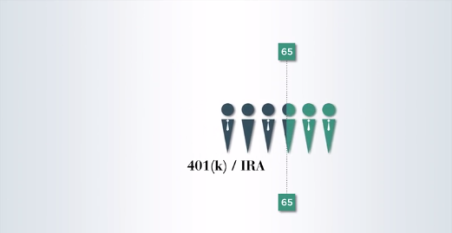It has become widespread practice for the higher earning spouse in a married couple to claim Social Security benefits at age 70. This will provide maximum income to the couple while that spouse is alive and to the surviving spouse after the death of either spouse. Once couples see the numbers, it doesn’t take a lot of arm twisting to get them to agree. Those that haven’t yet claimed set their sights on a claiming age of 70 and often decide to work until then. Those that claimed early without realizing how much they would be giving up often agree to suspend at full retirement age so their benefit can build 8% annual delayed credits to age 70.
 What is not so clear-cut is when the lower earning spouse should claim. (Note: for pronoun purposes we are assuming the lower-earning spouse is a woman and the higher-earning spouse is a man because that’s generally how it is…for the baby boomer generation at least.) First let’s clear up one misconception. Some clients think it’s OK for the lower-earning spouse to take a reduced benefit at 62 because she will be jumping up to 50% of her husband’s benefit when she turns full retirement age. That’s not how it works. If she files at 62 she will be paid 75% of her PIA as her permanent benefit. When she files for the spousal benefit at FRA, she will be paid the difference between her PIA and one-half of his PIA, and this amount will be added to her existing reduced benefit. This will give her a combined benefit that is less than 50% of his PIA.
What is not so clear-cut is when the lower earning spouse should claim. (Note: for pronoun purposes we are assuming the lower-earning spouse is a woman and the higher-earning spouse is a man because that’s generally how it is…for the baby boomer generation at least.) First let’s clear up one misconception. Some clients think it’s OK for the lower-earning spouse to take a reduced benefit at 62 because she will be jumping up to 50% of her husband’s benefit when she turns full retirement age. That’s not how it works. If she files at 62 she will be paid 75% of her PIA as her permanent benefit. When she files for the spousal benefit at FRA, she will be paid the difference between her PIA and one-half of his PIA, and this amount will be added to her existing reduced benefit. This will give her a combined benefit that is less than 50% of his PIA.
Nevertheless, some couples want to start the lower-earning spouse’s benefit early to get some Social Security income rolling in while the higher-earning spouse delays. Is this the best strategy for them?
Let’s look at it from a breakeven point of view. Claiming at 62 will give the lower-earning spouse more checks but in a lower amount. Claiming at 66 or 70 will provide a higher benefit but over a shorter period of time. The breakeven age is the age at which more total benefits are received under the later-claiming scenario than under the early-claiming scenario. Our calculators show us that when you are comparing 62 to 70, breakeven age is 78. If you are comparing 66 to 70, it’s 82.
But for couples there’s a twist. Because the higher-earning spouse’s benefit will transfer over to the lower-earning spouse as her survivor benefit, it will be necessary for the higher-earning spouse to outlive the lower-earnings spouse’s breakeven period in order for the delay to pay off. In other words, if he dies early, the lower-earning spouse would have been better off grabbing those reduced benefits starting at 62 because she’ll be giving up her reduced benefit for the higher survivor benefit before her breakeven age. (Note: Unlike with spousal benefits, there will be no reduction in the survivor benefit as long as the widow claims it at her FRA or later, even if she claimed her own benefit at 62. The survivor benefit is a whole new benefit, not an add-on.)
So you are looking not just at the age the lower-earning spouse will be when she dies. You are also looking at the age the higher-earning spouse will be when he dies, and whether it happens during or after the lower-earning spouse’s breakeven period. Got that?
The most extreme example of the delay not paying off is when the higher-earning spouse dies when the lower-earning spouse is age 70. In that case the lower-earning spouse would have foregone eight years of benefits only to transfer over to the same higher benefit she would have gotten if she had filed at 62.
The most extreme example of the delay paying off is when both spouses live to age 100. In that case the lower-earning spouse is enjoying for many, many years the higher benefit she got by delaying. For every year after the breakeven age that they both remain alive, the more the delay pays off.
Because there can be a disparity in the spouses’ ages, it’s more accurate to look at the breakeven period, not the lower-earning spouse’s breakeven age. If the lower-earning spouse’s breakeven age is 78, that’s a period of 16 years (from age 62 to 78). Add this to the higher-earning spouse’s current age to see how long he must live in order for her delay to pay off. If he is 70 when she is 62, he must live another 16 years to age 86 in order for her delay to pay off. This may not be worth it, especially if he is in poor health. If he’s the same age she is, he only has to live until age 78. If he is younger, say 58, breakeven occurs when he is only 74. In that case, it would almost certainly make sense for her to delay.
By the way, if you want to consider the time value of money with a reinvestment rate of 3% over inflation, the breakeven age is 84 if you are comparing 62 to 70 or 86 if you are comparing 66 to 70.
 First, I like to consider the pure breakeven age, without reinvestment, taxes, or other variables which are unknowable. This results in a lower breakeven age and doesn’t require clients to reinvest Social Security benefits or other assets at a specific rate of return in order for the strategy to work. (Sometimes the alternative source of income, while Social Security is being delayed, is to continue working.) Second, I think the average life expectancy is irrelevant when you are working with live human beings who comprise their own little risk pool. By definition, half of all people will outlive the average life expectancy, and there is some evidence that affluent, educated baby boomers will live longer than average. Third, and most important, the conclusion can vary considerably depending on the respective ages and PIAs of the spouses. Until you put a client’s numbers into a calculator, it’s all theoretical.
First, I like to consider the pure breakeven age, without reinvestment, taxes, or other variables which are unknowable. This results in a lower breakeven age and doesn’t require clients to reinvest Social Security benefits or other assets at a specific rate of return in order for the strategy to work. (Sometimes the alternative source of income, while Social Security is being delayed, is to continue working.) Second, I think the average life expectancy is irrelevant when you are working with live human beings who comprise their own little risk pool. By definition, half of all people will outlive the average life expectancy, and there is some evidence that affluent, educated baby boomers will live longer than average. Third, and most important, the conclusion can vary considerably depending on the respective ages and PIAs of the spouses. Until you put a client’s numbers into a calculator, it’s all theoretical.
That said, I can see that it might pay off for a lower-earning spouse to claim early benefits, even if it is not the so-called optimal scenario. I’ve seen cases where the difference between the #1 and #2 scenario is small enough that the couple is willing to forego a few more thousand dollars in lifetime benefits in order to start Social Security income at age 62. That’s their choice and there’s probably not much downside, especially if starting the lower-earning spouse’s benefit at 62 will help convince the higher-earning spouse to delay to 70. And if the higher-earning spouse is over FRA and eligible to file a restricted application for his spousal benefit off the lower-earning spouse’s record, it can help mitigate some of the losses arising from early claiming. Again, this is why you need to contact our office at 215-886-2122 to run the scenarios in our “Spousal Planning Calculator” after having an in-depth conversation with you about goals, income needs, health status, life expectancy, and so on. The consultation without the calculation is incomplete, as is the calculation without the consultation.


